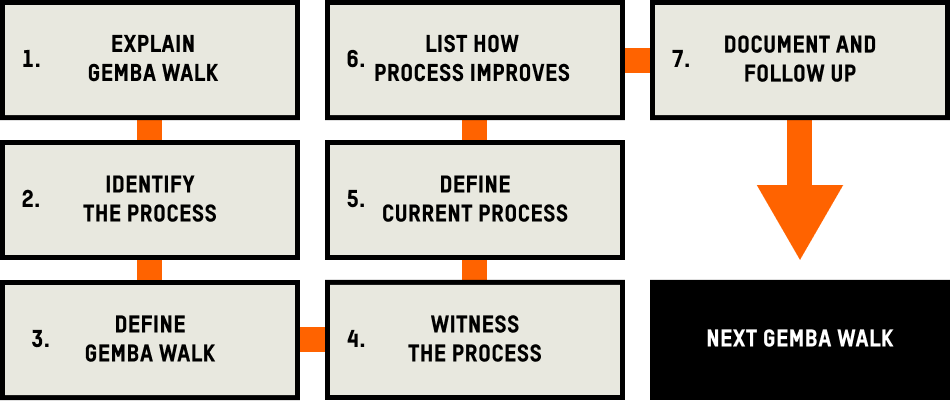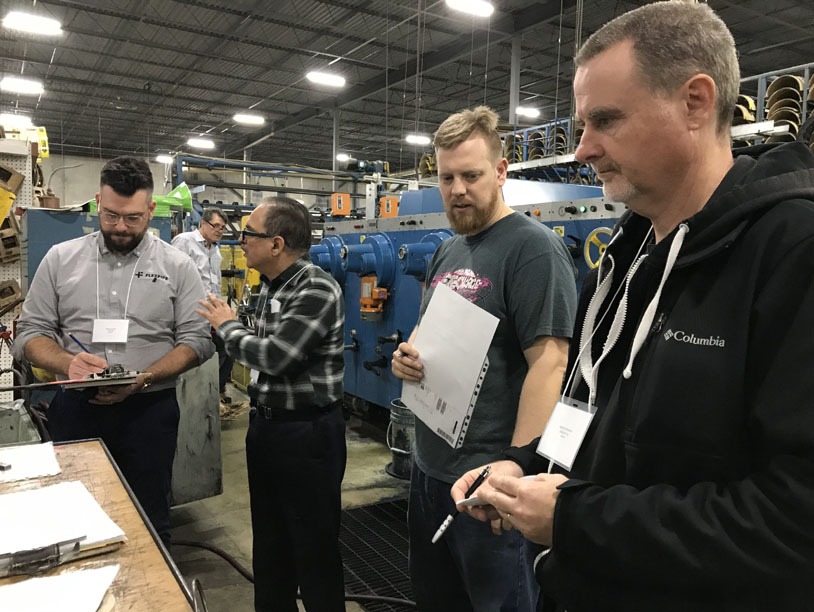7-Step Gemba Walk to Reduce Manufacturing Waste
In lean manufacturing and continuous improvement environments, the Gemba Walk is the all-important first step to starting the day. It aligns expectations, what work must be completed, reviews work processes, and empowers managers and employees to identify potential waste and improvements. Manufacturers use the Gemba Walk daily to improve operations and reinforce a continuous improvement mindset.
Gemba is Japanese for “Gembutsu,” with translates to “the real place.” It forces managers and supervisors to see how work is performed in person. So, why is this so important? Why is seeing work in person critical to improving and reducing waste?
Working in Your Office Has Its Limits
The purpose of a Gemba Walk is to get line-side managers and supervisors out of their offices and onto the shop floor. It challenges them to identify systemic problems in how work is performed. It helps eliminate everyday roadblocks that prevent employees and production technicians from achieving their daily objectives.
Far too often, managers and supervisors rely upon their experience. They manage minute details based on their familiarity with a given work process. They’ve done it themselves. They know the process in and out. Who better to manage these processes than them?
Unfortunately, they’ve completely forgotten that manufacturing environments are constantly changing. Left alone, employees will start making their own decisions. Some of these are altruistic, making whatever improvements they can because they think it will help them and their co-workers. Some are selfish, such as resource-guarding materials and the best tools and equipment.
This is an all-too-common occurrence. Gemba Walks force managers and supervisors away from that comforting mindset. It takes the decision out of the hands of a single employee. It challenges managers and employees to find better, more expedient ways to do the job by dealing with how things are now. It builds rapport by empowering both to work together to solve common and uncommon problems.
Most importantly, it aligns goals and objectives and minimizes sources of waste. Here are the critical steps to making a Gemba Walk work.

1. Explain What a Gemba Walk is to Your Team
The last thing you want to do is spring this on your employees. Doing this won’t work. Instead, gather your team and explain how and why manufacturers perform Gemba Walks. Explain its history, why it originated, and how it can help everyone perform better while eliminating redundant and time-consuming problems and processes. If positioned correctly, your team will view the Gemba Walk as a great way to express their ideas and make their jobs easier.
2. Identify the Process You’re Analyzing
In this initial step, you want to define which work process you’ll review with the employee. Make sure the work process is clearly defined before starting. While the goal is to improve the process, if need be, having one, to begin with, is critical.
If you are analyzing a workstation, then define how that workstation has performed. Take note of any existing key performance indicators (KPI) and metrics. Finally, prepare a list of questions based on your experience about how the work task should be completed. While the Gemba Walk aims to identify any causes of waste, it’s always good to have a baseline of the work process.
3. Define a Time for the Gemba Walk
The most appropriate time for a Gemba Walk is in the morning. However, a scheduled Gemba Walk can take place anywhere during the day. Don’t make the all-too-common mistake of scheduling multiple Gemba Walks consecutively to finish off as many as possible in a single day. Instead, plan out your Gemba Walks during the week.
A good rule of thumb is to spend at most 45 minutes for each Gemba Walk for each process. You can schedule one Gemba Walk a day for a different process. Spreading your Gemba Walks will help you and your employee better prepare. It gives you time to gather your thoughts, review previous KPIs, assess past problems, and review the existing process.
4. Witness the Process
Make sure to focus and observe the process. Make sure to distinguish the process from how the employee works. The goal is to see the process as is, flaws and all. Identifying problems, roadblocks, redundant processes, and approvals will isolate wasted time and eliminate its root causes.
Don’t get frustrated by what you initially observe. This is precisely why the Gemba Walk is so important. You may observe issues that can easily be solved but ones where the employee couldn’t make the change. There are numerous reasons why work stoppages occur, so keep track of how often and why they occur.

5. Define How the Process Currently Works
As you watch the current work process unfold, note the causes of idle or wasted time. Allow the work process to develop. Do not start making immediate changes. The goal is to understand how the current process works, where the gaps are, and what’s causing work stoppages and wasted time.
For now, write out how the current process is being used. It may differ from the original process. This is common. Over time, employees and managers may adjust work processes without tracking what was changed or why. It can include moving equipment and machinery closer or away from the work location or making minor adjustments based on the employee’s skill level.
6. Identify How the Process Can Improve
This is where you break down how the current process works and how it can be improved. You’re filling in the gap between the actual and ideal processes. The notes you took about the root causes of downtime, work stoppages, and wasted time can now be addressed.
Some changes may be simple, while others may be more complex. Make it easy for yourself. Tackle the easy ones first and then create a schedule on how the more complex issues will be dealt with. As you perform other Gemba Walks for different work processes, you might develop a clearer picture of how to fix the more complex issues.
An example might include two adjacent workstations where equipment or machinery was slightly moved for safety reasons. That slight adjustment made one work cell function better while the other became more cumbersome. However, you’ll only see that once you’ve performed multiple Gemba Walks.
7. Document and Follow Up
Ensure to properly document every change you and your employee have made or will make. You don’t want to make the same mistakes of the past where minor adjustments or major changes to the process weren’t captured.
Again, for the easy fixes, they should be done immediately. For those that are more complex, use a schedule or timeline where the changes can be enacted. Make sure you clearly define a follow-up date with your employee. Remind them that this is a never-ending process; continuous improvements never end.
Gemba Walk Checklist
Having a readymade list of questions to ask your employee during the Gemba Walk helps to ensure you and your employee don’t go beyond the 30 to 45 minutes. It’s common for those first performing a Gemba Walk to get stuck on a specific step or issue.
The following questions will help you focus on what matters while ensuring your employee can provide the correct answers to support the exercise.
Questions to ask before the work process starts.
- What is the current process you’re performing?
- Has this process been adequately explained to you?
- Are there any immediate concerns about the process before you start?
Questions to ask while observing the work process.
- What caused that delay?
- How often does this delay happen?
- Can you solve this problem yourself, and if so, how long does it take?
- Do you know whom to speak with once this issue occurs too often?
Items to discuss towards the end of the Gemba Walk.
- Ask the employee what they think is best to resolve the most common issues.
- Make sure the employee feels part of the process.
- You should have a list of issues to pursue
- The employee can resolve some issues before the next scheduled Gemba Walk
- Other issues will require more time and perhaps the entire team’s input.
Importance of Capturing the Causes of Work Stoppages/Downtime/Lost Time
Don’t gloss over the changes you make. Complacency is commonplace, but the Gemba Walk only works if you properly track and document each of your changes. Properly capturing the causes of work stoppages and delays will allow you to isolate common root causes.
Detailed notes will ensure your team doesn’t fall back into old habits. Sometimes it’s because they’re not convinced the changes will be followed up. Sometimes it’s because they forget or assume it’s not essential. Regardless, establishing expectations with your employees goes together with taking diligent notes.
Simple Solutions from Flexpipe
Flexpipe is a North American-based designer, innovator, and sometimes assembler of modular and scalable tube and joint material handling solutions. The company’s tube and joint system originated from the Toyota Production System (TPS) and has been used in lean manufacturing environments for over 70 years.
Flexpipe provides tubes and joints that allow manufacturers to design and assemble modular material handling structures at a fraction of the costs compared to fixed, welded structures.
To learn more about how Flexpipe can reduce your material handling costs, contact us now.



